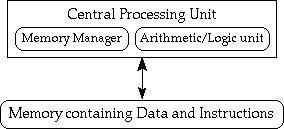
Neural Nets Introduction
Problem
Although all children know about computers and computers can be found almost everywhere in modern society, it was not so long ago that computers did not exist in there present form. It was only around the 1950s that computers were anywhere near recognisable and then they were large and could do little.
Today's computers do many things and to some may seem perfect but unfortunately they are not. Computers have been getting faster but there are limits. Because of the basic design of computers there is a bottleneck between the CPU and the memory of the computer,

and it becomes increasingly difficult to reduce the time for signals to go between the two components thus limiting the computers speed.
There is also the problem of programming. For every computer program someone must have worked out every single possibility so that the computer will be able to cope with all situation. This can be done for a word processor but trying to get a computer to recognise speech is very difficult because of all the possible variations.
Solution
One thing can already cope with the problems of speech recognition and also process information far faster than today's computers, that thing is, the brain. It has been adapted by millions of years of evolution to do its job. Now people are attempting to copy the methods that the brain uses to overcome the problems facing computers. These models of the brain are called neural nets.
Investigation
The investigation is divided into four parts.
- Section 1 gives a backdrop for the development of neural nets with the history of neurology, computers and early neural nets.
- Section 2 describes how individual neurons work, how nets are connected and how they learn.
- Section 3 has recent developments in neural nets, how they are being used today and what may come in the future.
- Section 4 closing comments.
| Abstract | History |
| About this site | Neural Nets | © Matthew Caryl |